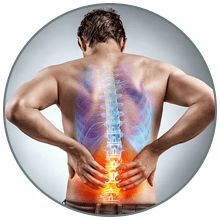Implantable Pumps for Spinal Infusion of Drugs
An implantable pump is a specialized device that delivers precise amounts of concentrated drug into the intrathecal space through a small catheter. The intrathecal space contains the cerebrospinal fluid. Spinal infusion is also called intrathecal infusion.
Implantable pumps are intended for patients with severe chronic pain that has not responded to other treatments. Some examples of diagnoses for which an implantable pump may be effective are: low back pain after failed surgery, cancer pain, sympathetic-reflex dystrophy, neuropathic pain, and severe pain from vertebral fractures.
These are patients who do not respond to pharmacological treatments or who suffer intolerable side effects.
The spinal infusion pump continuously administers small amounts of concentrated analgesic drugs, thus bathing the pain receptors located in the spinal cord. This provides pain relief and reduces or eliminates the need for oral or transdermal (patch) medication. As the medication is deposited directly into the nervous system, the doses required for most drugs are much lower.
Since it is impossible to know a priori whether or not a particular patient will benefit from continuous spinal infusion, it is very important to perform a preliminary test, which may consist of an injection of the drug to be used in the intrathecal space, or a temporary continuous infusion with an external pump for a few days. In the latter case, since there is a risk of infection, the control by the physician must be very close.
The implantation of the infusion system is performed in an operating room. It is not necessary to use general anesthesia, although it can be done depending on the characteristics and general state of health of each patient. Generally, deep sedation and local anesthesia are used.
The implant consists of two parts: the insertion of a fine catheter into the intrathecal space through a puncture in the lumbar or dorsal spine, and the placement of the implantable pump under the skin, generally in the abdominal region.
It is advisable to remain under observation for at least 24 hours in order to administer adequate analgesia and antibiotics.
Once the pump is implanted, it is filled with morphine or with the drugs to be used for the infusion. The infusion rate is programmed electronically with remote control.
These are some of the drugs frequently used for implantable pumps:
- Morphine: This is a potent opioid analgesic. It is the most commonly used drug in spinal infusions for the treatment of pain. As short-term side effects, it can cause nausea, vomiting, itching, leg swelling, drowsiness and urinary retention. These effects usually disappear within one to three days. A side effect to be taken into account is also the development of tolerance, i.e. the need to use higher and higher doses to achieve the same results.
- Bupivacaine: This is a long-acting local anesthetic which, together with morphine or other opioid drugs, enhances their action, significantly improving the analgesia provided by continuous spinal infusion.
- Clonidine: This is a drug with antihypertensive effects, which has high analgesic properties, especially if combined with other drugs. Among other side effects, it can produce a decrease in blood pressure, which sometimes prevents its use.
- Ziconotide: It is a new drug, extracted from a species of snail. It has been shown to be effective in many forms of neuropathic pain. It is used only by the spinal route.
- Baclofen: A muscle relaxant drug used in patients suffering from muscle stiffness or spasticity as a result of cerebral vascular accident, spinal cord injury, or other types of neurological disease. When therapeutic levels (effective in relieving symptoms) are reached, they generally remain stable for a long time.
The medication inside the pump lasts from one to three months, depending on the concentration and infusion rate that is programmed. Each time the medication in the pump runs out, it must be refilled by puncturing the pump implanted under the skin with a small needle. At each revision, the infusion rate and drug concentration parameters can be modified to improve pain control.
The pump battery runs out after a few years. The duration depends on the use of the pump. The battery cannot be replaced; the entire pump must be replaced. This requires a simple surgical procedure in which the site where the pump is located is incised, removed and replaced with a new one.
It is not advisable to perform an MRI on a patient with an implanted programmable pump. However, if absolutely necessary, it can be done following protocols that will be provided to radiologists and radiology technicians.
All patients will be provided with special identification indicating that a device has been implanted, in order to avoid going through security checks at airports.

CONTACT
If you wish to contact us, to make an appointment or request more information about our services, please do so here
Patient Reviews
After months of intense pain in my back and leg due to a hernia, and after being full of medications and rehabilitation sessions, finally a friend recommended this clinic and I was absolutely right. They visited me very quickly and Dr Ruiz performed a radiofrequency intervention that has solved the problem, it no longer hurts and I have regained my quality of life, which I had lost. I only have words of gratitude
I had a rhizolysis two years ago and it is the best decision I ever made. I was advised to go to this clinic. Excellent staff and treatment. I would come back without hesitation. I am a different person since I don’t feel any pain.
In a frankly desperate situation with my mother suffering from trigeminal neuralgia and with continuous and terrible pain during confinement and no public health doctor able to relieve her pain in any way, it was miraculous to find this center by surfing the internet. In just a couple of weeks after the initial visit, Dr. Ruiz operated on my mother in an outpatient and non-aggressive surgery and in just a few days she regained speech, mobility and finally began to sleep as she no longer suffered the tremendous pain. And if the treatment has been effective thanks to the hands of a great doctor, this does not mean that the whole team at the center is not deserving of credit. From the reception to the nurses, they are all exemplary professionals who make you feel safe and in good hands at all times. My mother is already another and just 4 months later we are aware that there is no better investment than health and Clínica Vértebra is a success. Totally recommendable. THANKS A MILLION.
It has been a long time since I felt what it was like to live without pain. I only have words of gratitude for the whole team, from the reception staff to the operating room team. Thank you Dr. Squarcia for such a detailed explanation of my problem and for the accuracy of the treatment. I pray to God that this wellness lasts for a long time.
I had a lumbar facet denervation (Rhizolysis) this morning and I have to say that «O» pain. It has been 10 hours since the intervention and I am still without any pain and without medication. Congratulations to the whole team. Viggo Adeler (Physician)
Good treatment and attention, I went with a horse sciatica and they left me like new, I only have words of thanks.
It is a place that has improved my quality of life.
I only have words of thanks to Doctors Ricardo Ruiz and Dr. Matias, I have gone to them twice, and I only have words of thanks, they have solved my problem, first of Lumbar vertebrae and the second of a shoulder, and in both cases total success, I have not returned to have any kind of discomfort, I am totally grateful to them, they have changed my life. THANK YOU DOCTORS, you are fantastic.
First visit with Dr. Mattia Squarcia, finally a doctor who listens to me and looks at all my medical tests. I have already had a bad experience with another pain clinic where the doctor did not listen to me and did not even look at a single medical test.
I have only words of thanks, thank you Doctor Ricardo Ruiz.







